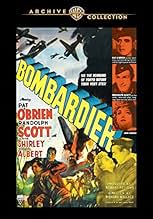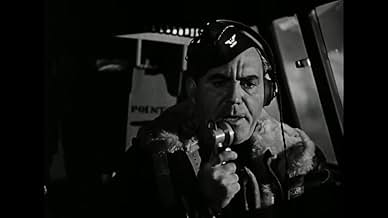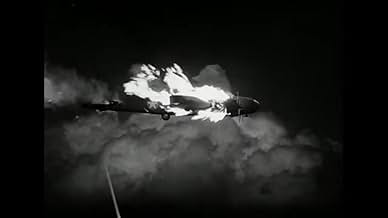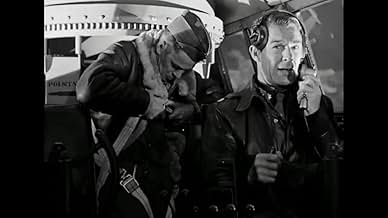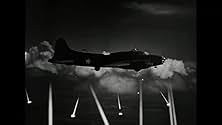Ajouter une intrigue dans votre langueMajor "Chick" Davis is convinced that high-level bombing will win the next war. He convinces the powers-that-be to set up a bombardier school. He efficiently sets about training the USAAF's ... Tout lireMajor "Chick" Davis is convinced that high-level bombing will win the next war. He convinces the powers-that-be to set up a bombardier school. He efficiently sets about training the USAAF's first generation of high-level bombardiers.Major "Chick" Davis is convinced that high-level bombing will win the next war. He convinces the powers-that-be to set up a bombardier school. He efficiently sets about training the USAAF's first generation of high-level bombardiers.
- Nommé pour 1 oscar
- 1 victoire et 1 nomination au total
- General Eubank
- (as Brigadier-General Eugene L. Eubank)
- Little Boy - Spy
- (uncredited)
- Congressman
- (uncredited)
- Buck's Secretary
- (uncredited)
- Soldier
- (uncredited)
Avis en vedette
Admittedly the dramatic plot was somewhat predictable. But you had a sense that there would be some interesting scenes as the movie went on. We were able to witness what appeared to be realistic training regimens and equipment.
Where this movie came together for me was closer to the end. The scenes had a realism (at least as I perceived it) that I haven't encountered often before. You could place yourself in the action and imagine the thoughts of the young combatants. This was mixed in with the usual problems of portraying passable Japanese soldiers at a time when you might think real Japanese actors would be somewhat scarce.
The movie is excellent as a source of the state of the American mindset in 1943 as the war waged with Japan. Also of interest was a dig at the Japanese with respect to the help the USA gave Japan in past years.
"Bombardier" tells and shows us the early days of training for this new position in the Army Air Forces – precursor of the U.S. Air Force. As such, it's a good educational piece for the public, then and now. The men who went into combat in different roles weren't tossed together and sent into combat. They were trained first. And for some fields, the training was highly specialized and detailed. This film shows very well that detail, study and science that went into the training of bombardiers. These men indeed played a critical role in destroying enemy armament production, fuel depots and major supplies – and in so doing, helped end the war much earlier than it would have otherwise concluded.
Many have said it since the first attribution to Civil War Gen. William T. Sherman, that "War is hell!" But once a nation is in a war, it should do everything possible to end it as soon as possible.
Many war movies have been made, especially about the two "great" world wars of the 20th century. They have variously focused on the action of troops in battles, assaults from the sea, naval engagements or air combat. Most give us a picture, however much Hollywood may "tweak" it, of the human conditions, relationships, and characters. Often times they include the strategic plans of real battle scenes. These are the things that most interest people, or "entertain" audiences for this genre. But films such as "Bombardier" add another value in educating and informing the public of what went into the readying of our nation for war, and our ability to win and end it as soon as possible.
As an Army paratrooper veteran, I enjoy learning about the "how-to" that men and women learn in the different combat and support specialties of our armed services. People who approach war movies in a similar frame of mind will be much more likely to enjoy them. I highly recommend "Bombardier" as an informative, action-filled and historical war movie.
There is no way that the bombers are that accurate. Those bullseye targets are impossible until laser-guided bombs. In fact, something as big as a tank would be hard to hit by any plane of that era. Of course, this is wartime propaganda and it serves its purpose. There is some miniature work along with the use of the real bombers. For its time, some of it actually looks good. The story is done in a straight, patriotic, and old fashion melodramatic way. There are a couple of familiar faces. It gets rather intense when some of them get captured which culminates in a bombastic patriotic flourish.
Le saviez-vous
- AnecdotesThe American bomb sight mentioned throughout the movie was the Norden bomb sight whose secret was almost as closely guarded as the development of the atomic bomb. It used a mechanical computer and linkage to the plane's autopilot to achieve an accuracy of hitting with 75 feet of the target from an altitude of 12000 feet. All members of the bomber's crew were ordered to destroy the sight at all costs if the plane was going to crash. Many ships carried a hand grenade to place under the sight to assure total destruction. It was used as late as 1967 to drop sensors along the Ho Chi Minh trail in Viet Nam.
- GaffesThe Douglas B18's, Beechcraft AT11's and B17 aircraft all sport national markings found from May 1942 until June 1943, yet a considerable part of this film takes place before Pearl Harbor.
- Citations
Burton Hughes: You're quite an entomologist.
Sgt. Archie Dixon: Nope! But I know all about bugs.
- Générique farfeluBrigadier General Eugene L. Eubank is billed first because he is credited in the forward before any cast is mentioned, and he is not listed in the comprehensive end credits.
- Autres versionsAlso available in a computer colorized version.
- ConnexionsReferences Au revoir, M. Chips (1939)
- Bandes originalesSong of the Bombardiers
(1942) (published title)
On-screen title: "Song of the U. S. Bombardiers"
Music by M.K. Jerome (as M. K. Jerome)
Lyrics by Jack Scholl
Played during the opening and closing credits and often in the score
Sung by the audience at the magic show
Meilleurs choix
Détails
- Date de sortie
- Pays d’origine
- Langue
- Aussi connu sous le nom de
- Ohne Rücksicht auf Verluste
- Lieux de tournage
- société de production
- Consultez plus de crédits d'entreprise sur IMDbPro
- Durée1 heure 39 minutes
- Couleur
- Rapport de forme
- 1.37 : 1
Contribuer à cette page



